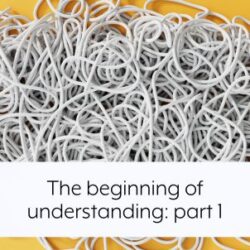
Dissociative identity disorder is a post-traumatic condition which results, amongst many other symptoms, in ‘multiple parts of the personality’. One of the most common questions from therapists and supporters is: ‘Should I talk to parts?’ What most people mean by this is, when a person with DID ‘switches’ from their main adult personality state into a different ‘part’, ‘self-state’ or ‘alter’, should they engage with this ‘part’ or not? When someone switches in this way, is this attention-seeking behaviour which should be discouraged? And is talking to a ‘part’ in some way dangerous – does it reinforce pathological behaviour? What should you do?
Often people are looking for a definitive ‘yes’ or ‘no’ response; I believe the answer lies, like so many things, in the context. We therefore need to be aware of some guiding principles, rather than setting black-or-white ‘rules’. To shed some light on this complex topic, let’s look at some of the reasons that have been proposed for why we shouldn’t talk to parts, and the arguments why we perhaps should.
Are parts real? Does dissociative identity disorder actually exist?
The primary argument against talking to parts is that they are not ‘real’ and that dissociative identity disorder does not exist, at least not as a valid psychiatric diagnosis. This way of thinking comes from a school of thought, led by researchers such as Spanos (1994), called the ‘sociocognitive model of dissociative identity disorder’. This proposes that instead of DID resulting from trauma, it instead arises as a result external influences: DID is primarily ‘iatrogenic’, created mainly by suggestion and reinforcement of the therapist, and also as a result of media portrayals from films such as The Three Faces of Eve and Sybil. In other words, people act like they have multiple personalities for personal gain (usually to elicit attention or care), encouraged by their well-meaning but misguided therapist. But is this really so?
David Gleaves (1996) argued coherently against this model in his paper, The Sociocognitive Model of Dissociative Identity Disorder: A Reexamination of the Evidence. However, many of the ideas put forward by Spanos and his colleagues, despite being robustly rebuffed, have caught hold in many sections of the psychiatric world, leading to an orthodoxy which contends that DID is not real and that ‘parts’ are a ‘multiple identity enactment’ encouraged and reinforced by the therapist. Consequently, given the little training that many professionals have had regarding dissociative disorders, and especially their origin in early life trauma and attachment difficulties, the prevailing belief seems to be that talking to parts will make things worse, and that the therapist or other professional should insist on talking only to the adult self. This causes a great deal of frustration for people with genuine DID – in many cases they feel that they have to stop having the disorder for which they are seeking in treatment, in order to access that treatment.
The sociocognitive model suggests that ‘people who receive the diagnosis of multiple personality disorder (MPD) behave as if they have two or more distinct identities’ (Spanos, 1994, p.143) – not that they do have two or more distinct identities. The ISSTD Guidelines refute this comprehensively:
Severe and prolonged traumatic experiences can lead to the development of discrete, personified behavioural states (i.e. rudimentary alternate identities) in the child, which has the effect of encapsulating intolerable traumatic memories, affects, sensations, beliefs, or behaviours and mitigating their effects on the child’s overall development. Secondary structuring of these discrete behavioural states occurs over time through a variety of developmental and symbolic mechanisms, resulting in the characteristics of the specific alternate identities. The identities may develop in number, complexity, and sense of separateness as the child proceeds through latency, adolescence, and adulthood (R P Kluft, 1984; Putnam, 1997).
Furthermore, the sociocognitive model posits that individuals with DID are generally attention-seeking (histrionic) and this is the main motivating factor for pretending to have ‘parts’. However, Gleaves and many other researchers (e.g. Kluft) insist that the vast majority of people with DID hide their symptoms rather than seek attention for them. The orthodoxy of not talking to parts is based on this misconception that alternate identities are a manipulative form of attention- and care-seeking: engaging with them would therefore encourage and maintain the pathological behaviour. But the ISSTD Treatment Guidelines conceptualise dissociative parts of the personality as resulting from a combination of trauma and developmental deficits. The work of therapy therefore is to help the client come to terms with the existence of their parts, and “to foster the idea that all alternate identities represent adaptive attempts to cope or to master problems that the patient has faced.” In fostering a collaborative relationship with parts, it is possible to work to resolve the trauma that necessitated them. The Guidelines go on to say: “It is countertherapeutic to tell patients to ignore or “get rid” of identities” (ISSTD, 2011) – and so surely it is also countertherapeutic for the therapist also to do so.
Does talking to parts encourage more splitting and dissociativity?
The ISSTD Guidelines warn against the elaboration of distinct identity states, saying:
It is countertherapeutic to suggest that the patient create additional alternate identities, to name identities when they have no names (although the patient may choose names if he or she wishes), or suggest that identities function in a more elaborated and autonomous way than they already are functioning.
In other words, the function of therapy is not to try to uncover increasing numbers of parts or ‘alters’ or to encourage them to operate independently from one another: the goal of therapy is increased wellbeing and functioning across the entire spectrum of personality. Engaging with parts who present spontaneously in the course of therapy does not in and of itself encourage either elaboration or increased disconnection. The reality is that the client has a dissociated sense of self, and refusing to speak to parts when they appear – in essence as a form of attempted behavioural modification – is most likely to disrupt the therapeutic alliance, provoke shame, and actually increase a sense of separateness.
Many parts represent disowned aspects of the self (such as vulnerability, emotional expression, attachment, etc) or disavowed experiences – especially traumatic ones. In refusing to engage with parts, their function, role and experiences are in fact kept segregated from the person as a whole, rather than being integrated into it. The sense of shame, alienation and rejection that many dissociative clients experience when professionals refuse to engage with or acknowledge their parts can cause further dissociative distancing.
Is switching merely a maladaptive avoidance strategy?
Dissociation is indeed a strategy of avoidance, but one that results from life-threatening and traumatic circumstances, and one which carries significant cost. Dissociation is what has allowed the person to survive both the original trauma, and the effects of it up until this point. To insist on abandoning this defence at the outset of therapy – before having developed alternative tools for managing intense distress, amongst other things – is counter-therapeutic and could result in serious decompensation.
Instead I believe that therapy is the place that the client, with all their dissociated parts, can begin to learn to manage their feelings, to acknowledge and own the segregated aspects of themselves, and build a secure base that provides the platform for exploration of traumatic material. That is only going to happen if the client feels that they are welcome and accepted – that all of them is welcome and accepted. By welcoming and working with parts, the therapist builds trust and a sense of safety. By rejecting them, the therapist reinforces the belief that these parts of the self are unacceptable, that the experiences they had are unspeakable, and that using dissociation as a survival mechanism was in some way ‘wrong’.
Does the client needs to stop dissociating in order to take responsibility and make progress in life?
It is certainly true that recovery requires an increasing willingness to take responsibility for one’s actions, beliefs, feelings, choices and behaviours. It is also true that many people feel out of control and unable to take responsibility for the actions of their parts due to a lack of co-consciousness or memory afterwards. They can feel in a double-bind where they are told that they need to be responsible for their parts, but they have no conscious awareness of them.
It is a Catch-22 situation if a therapist says that they won’t engage with parts, and yet the client has to take responsibility for them. In my opinion, the best way for people with dissociated identities to begin to take responsibility for their parts is to get to know them. The therapist can facilitate this process by beginning to engage with the parts directly, and then acting as a ‘relational hub’, gently and carefully feeding back to the client their experience of their parts, to increase awareness of each other, and encourage communication, cooperation and collaboration.
Does the adult need to be present to process trauma?
The ideal – and in many respects the end-goal – of therapy is needed for the client to be able to keep online their thinking, ‘front brain’ (principally the neo-cortex) during a therapy session in order to be able to both ‘think and feel’ simultaneously whilst processing traumatic material. But you have to start somewhere, and if the trauma is so overwhelming or shameful that the client in their adult self cannot face it, then initially it may be parts who are able to start to articulate their experiences and to begin to come to terms with them.
The ultimate aim is to integrate the memories and feelings into the person as a whole, so that the trauma can be resolved and stops activating as something that is recurring in the present rather than remembered as an event from the past. However, as a step towards that it can be helpful to first start working with the parts who hold those memories and feelings. Research shows that many memories are ‘state-dependent’ and are only accessible to certain identity states (the parts who experienced the trauma, for example). If these memories are only accessible via these parts, there will be stalemate if the therapist insists on talking only to the adult part, whose role to date has been to avoid all knowledge and awareness of that trauma. A better solution would be for the therapist to help the client to become more co-conscious of their traumatised parts and able to reflect upon what they are remembering and experiencing, as a first step towards owning that material for themselves.
Does talking to parts merely reactivate the trauma?
It is true that many parts hold memories and emotions connected with the trauma, and at a structural dissociation level are stuck in a defensive action system which is focused on the trauma (and defending against it) rather than on daily living. But that is how the person as a whole has survived. Can you imagine carrying the weight of trauma such as sexual abuse, rape, prolonged neglect, or emotional abuse – all alone, and never being allowed to talk about it or disclose it? This is what drives so much of the survivor’s desperate behaviours and distress. Providing a safe place in therapy to begin to talk about the unspeakable is like letting the steam out of a pressure cooker.
That is not to say that the lid should be taken off quickly or carelessly – it is important to build strategies for staying, relatively speaking, within a ‘window of tolerance’ and to manage the distress that disclosure inevitably leads to. But if there is no safe space within therapy for dissociative survivors to do this, the reality is that they are likely to leak out their trauma with less well-trained and less boundaried people. It is surely preferable to do this within the therapy session, and to work hard at maintaining a balance of disclosure with stabilisation for the client as a whole.
Who is the client – the main ‘host’ or the ‘parts’?
I believe that one of the pitfalls in working with dissociative identity disorder is a ‘black or white’ approach that either takes the multiplicity of parts of the personality as literal, or disregards it as delusional. The reality lies, I believe, in understanding that parts are and feel real, but that they are not actual, separate people with no connection to one another. There is one person, one client, with many parts, and in some respects this is no different to non-DID people: we all have parts. The difference for people with DID is that there is often amnesia between parts – ‘gaps’ – and parts hold fundamentally different ways of perceiving the world, relating to it, and surviving. There is little or no overlap, and no sense of unitary connection – it is a fundamentally different way of being.
The answer to this disconnection is not to disconnect further by refusing to talk to anyone other than the main person (called by some the ‘host’). The answer is engaging all the parts, and starting to help them make connections with each other, by becoming aware of one another and working cooperatively together. Keeping ‘secrets’ between the parts is counter-therapeutic and simply re-enacts the secrecy of the abuse environment. To a large degree, the person has survived by blocking awareness of his or her parts; the therapist needs to gently reintroduce him or her to them, not so fast that it floods and overwhelms, but not so slow that the segregation remains unchallenged. The client is the person as a whole, including all their parts – both those that have made themselves known and those that are yet to – and the therapist should model to the client collaboration with all of his or her parts.


